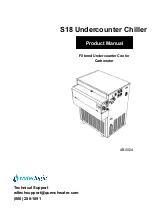
7
Determining Equivalent Line Length
To determine the appropriate size for field installed
liquid and discharge lines, it is first necessary to
establish the equivalent length of pipe for each line.
The equivalent length is the approximate friction loss
from the combined linear run of pipe and the
equivalent feet of elbows, valves, and other
components in the refrigeration piping. The sum
total is the equivalent length of pipe that would have
the same pressure loss. See the ASHRAE
Refrigeration Handbook for more information.
Follow these steps when calculating line size:
1.
Start with an initial approximation of equivalent
length by assuming that the equivalent length of
pipe is 1.5 times the actual pipe length.
2.
Determine approximate line sizes by referring to
Table 2 for liquid lines, Table 3 and Table 4 for
the discharge lines.
3.
Check the line size by calculating the actual
equivalent length using the equivalent lengths
as shown in Table 5.
CAUTION: When calculating the equivalent
length, do not include piping of the chiller unit.
Only field piping must be considered.
Table 1 – Equivalent Lengths of Elbows
Line
Size
OD
(in)
Equivalent Lengths of Refrigerant Pipe (feet)
90°
Standard
90°
Long
Radius
90°
Street
45°
Standard
45°
Street
½
1.4
0.9
2.3
0.7
1.1
⅝
1.6
1.0
2.5
0.8
1.3
⅞
2.0
1.4
3.2
0.9
1.6
Liquid Line Sizing
The liquid line diameter should be as small as
possible while maintaining acceptable pressure drop.
This is necessary to minimize refrigerant charge. The
total length between the chiller unit and the air-
cooled condenser must not exceed 200 actual feet
or 300 equivalent feet. It is best to pipe the liquid
line so that there is an immediate drop of at least 15
inches at the condenser outlets to make a liquid seal.
Liquid line risers in the system will require an
additional 0.5 psig pressure drop per foot of vertical
rise. When it is necessary to have a liquid line riser,
make the vertical run immediately after the
condenser before any additional restrictions. The
liquid line risers must not exceed 10 feet in height
from the condenser liquid line connection. The liquid
line does not require pitching. Install a pressure tap
valve at the condenser to facilitate measuring
pressure for service.
Liquid lines do not typically require insulation.
However, if exposing the lines to solar heat gain or
temperatures exceeding 110 °F, there is a negative
effect on sub-cooling. In these situations, insulate
the liquid lines.
Table 2 – Liquid Line Sizes for R407c
3 Ton Circuit (R407c) Liquid Line Size (Inch OD)
Equivalent
Length (Ft)
Horizontal
or
Down Flow
Up Flow (Feet of Run)
0 to 5
6 to 10
11 to 15
25
½
½
½
½
50
½
½
½
½
75
½
½
½
½
100
½
½
½
¾
125
½
½
½
⅝
150
½
½
⅝
⅝
175
½
⅝
⅝
⅝
200
½
⅝
⅝
⅝
225
⅝
⅝
⅝
⅝
250
⅝
⅝
⅝
⅝
275
⅝
⅝
⅝
⅝
300
⅝
⅝
⅝
⅝
Discharge (Hot Gas) Line Sizing
The discharge line sizes depend on the velocity
needed to obtain sufficient oil return. It is very
important to minimize line length and restrictions to
reduce pressure drop and maximize capacity.
Upflow hot gas risers need to have a trap at the
bottom and reverse trap at the top. In addition, a
trap and reverse trap arrangement needs to be
spaced every 15 feet in the rise for oil management
(see Figure 5).
The discharge lines should pitch downward, in the
direction of the hot gas flow, at the rate of ½ inch
per each 10 foot of horizontal run. If the chiller unit
is below the condenser, loop the discharge line to at
least 1 inch above the top of the condenser. Install a
pressure tap valve at the condenser to facilitate
measuring pressure for service. Take careful
consideration in the design of the discharge gas
riser.
Содержание Accuchiller EQ Series
Страница 1: ...Installation Operation Manual EQ Series Portable and Remote Condenser Chillers ...
Страница 2: ...Page Intentionally Blank ...
Страница 4: ...Page Intentionally Blank ...
Страница 27: ...Notes ...












































